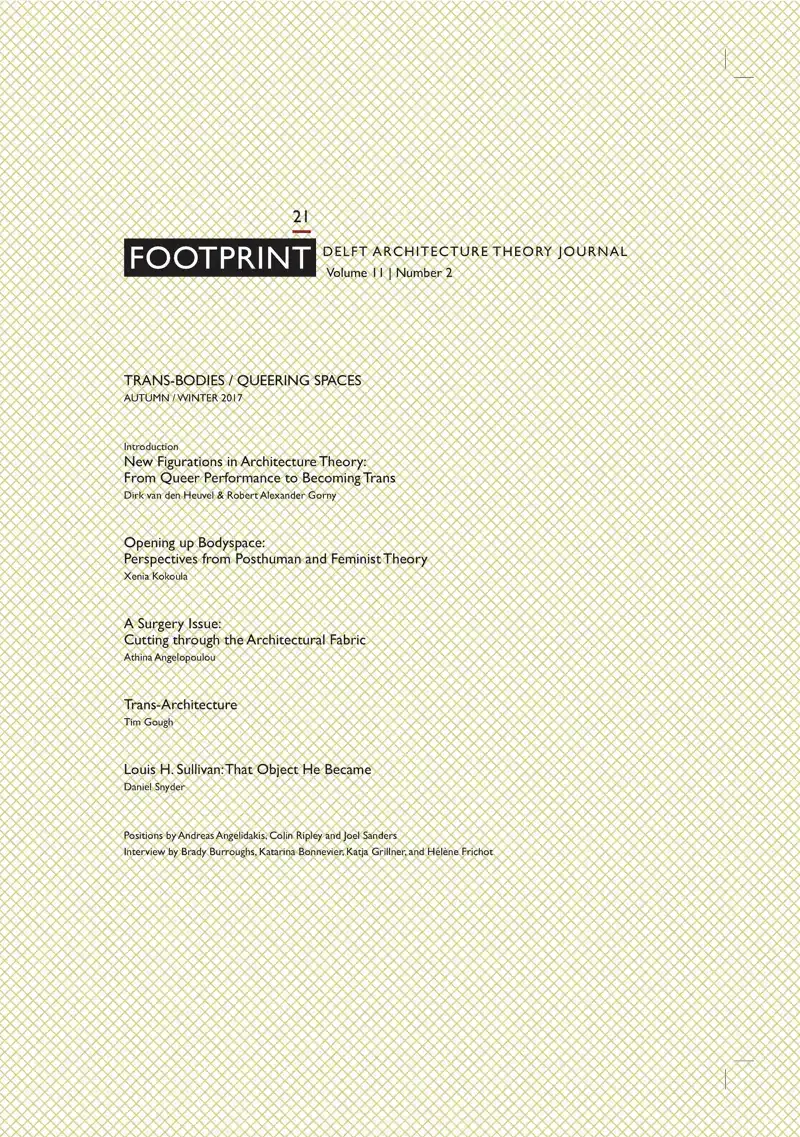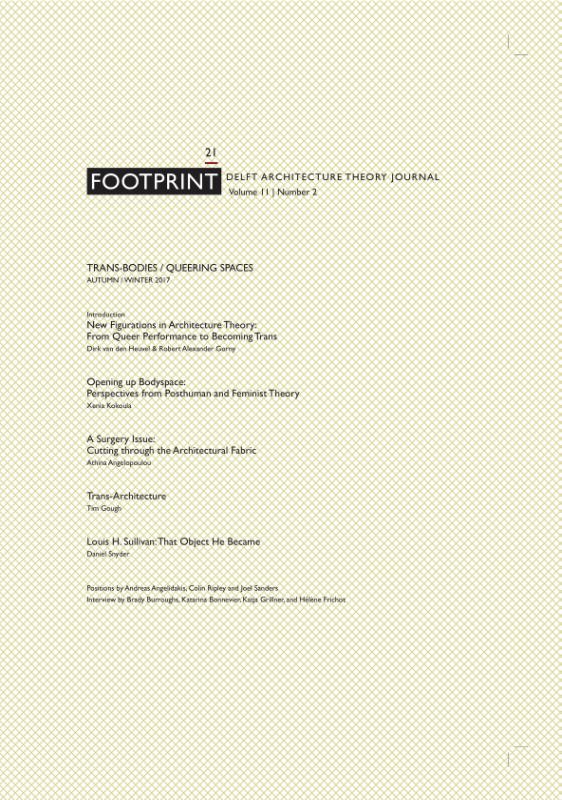- Engels
- Pockets
- kunst algemeen
- bouwkunst, archit.
- FOOTPRINT 21 TRANS-BODIES / QUEERING SPACES
JAP SAM BOOKS
FOOTPRINT 21 TRANS-BODIES / QUEERING SPACES
25,00incl BTW
Vertrouwd sinds 1927
Persoonlijke aandacht en advies
Vanaf 17,50 gratis verzenden NL & BE
Meer dan 150.000 artikelen online
Omschrijving FOOTPRINT 21 TRANS-BODIES / QUEERING SPACES
This issue of Footprint aims to introduce the latest developments in the field of queer theory into the realm of architecture and urban design - and vice versa, to make architectural and urban design concerns an element of queer studies. Next to uncovering hitherto hidden or repressed histories and practices as part of an agenda of inclusiveness, we consider an introduction of queer theory to architecture as engendering a radical reconceptualisation of the architectural discipline: That is, to upset and replace any conception of architecture as an embodiment of essentialist identities, forms or types, in order to move towards an understanding of architecture as a practice engaged in consistent transformation. Such a reconceptualisation of architecture views difference in terms of process, foregrounds liminal situations, their metamorphosis and transgression.
Within queer theory one finds various contesting propositions regarding the very definition of ''queer'' and acts of queering, especially now LGBTQI identities have become part of mainstream culture in western societies. Generally speaking, these propositions range from the mapping of queer identities - sometimes as another category in a taxonomy of essentialisms - to the idea of queering as performative acts of activist subversion and subjectivation. Such acts of queering resist the establishment of stable identities, while they promote transitory assemblages that are embedded within an unfolding process of differencing.
A first concern is here the ''logics'' in which these differences are produced and conceptualised, the concomitant disciplinary power structures and the epistemological frameworks that sustain these logics. The most radical variants of queering seek to undermine any bipolar, mutually exclusive opposition as in the case of heterosexist normativity and any other hegemonic discourse based on classic structuralist ''twin-phenomena'' such as male-female, inside-outside, centre-periphery et cetera. Arguably, the recent coming-into-mainstream of transgender issues placed full attention on bodily transitioning processes themselves. In their fierce act of self-displacement, trans-bodies overcome dualist logics by exploring the transgressive dimensions involved in forms of becoming.
Such tension between essentialism and becoming can already be observed in earlier attempts at connecting queer theory and architecture: in Queer Space (1997) Aaron Betsky proposed familiar gay tropes such as the closet and the interior, or hedonistic urban lifestyles as the ultimate spaces of queer identities, whereas Stud (1996) edited by Joel Sanders suggested a more complicated relationship between space and gay identities by clarifying that there is no ''queer space'', only space put to queer use (Chauncey, in Sanders 1996, 224).
Another vector of productive debate regarding this queering can be located between the discursive and the body, between language and matter. Judith Butler famously understands the formation of gendered identities, their enactments and possible undoing as performative. Alternatively, Rosi Braidotti''s feminist re-reading of Gilles Deleuze''s concept of becoming starts with an emphasis on the conditioning, generating and accommodation of difference as belonging to situated material processes from one moment of actualisation to another. The difference that bodies make is here no longer seen as a formation ''in'' space or ''in'' an environment, but actualised as a figuration ''of'' its material milieu (Barad, Bennett). A body (architecturally or otherwise) is understood as a transient and reciprocal form-taking of a milieu - unlike a singular entity contained by and acting in a neutral ''space'' or ''environment''. Such trans-bodies are not just in a state of transition themselves, they also trigger a transformation of the environment they traverse and populate, a queering of spaces indeed.
With contributions by: Dirk van den Heuvel & Robert Alexander Gorny (eds.), Xenia Kokoula, Athina Angelopoulou, Tim Gough, Daniel Snyder, Andreas Angelidakis, Colin Ripley, Joel Sanders, and interview with Brady Burroughs, Katarina Bonnevier, Katja Grillner, and Helene Frichot.
Within queer theory one finds various contesting propositions regarding the very definition of ''queer'' and acts of queering, especially now LGBTQI identities have become part of mainstream culture in western societies. Generally speaking, these propositions range from the mapping of queer identities - sometimes as another category in a taxonomy of essentialisms - to the idea of queering as performative acts of activist subversion and subjectivation. Such acts of queering resist the establishment of stable identities, while they promote transitory assemblages that are embedded within an unfolding process of differencing.
A first concern is here the ''logics'' in which these differences are produced and conceptualised, the concomitant disciplinary power structures and the epistemological frameworks that sustain these logics. The most radical variants of queering seek to undermine any bipolar, mutually exclusive opposition as in the case of heterosexist normativity and any other hegemonic discourse based on classic structuralist ''twin-phenomena'' such as male-female, inside-outside, centre-periphery et cetera. Arguably, the recent coming-into-mainstream of transgender issues placed full attention on bodily transitioning processes themselves. In their fierce act of self-displacement, trans-bodies overcome dualist logics by exploring the transgressive dimensions involved in forms of becoming.
Such tension between essentialism and becoming can already be observed in earlier attempts at connecting queer theory and architecture: in Queer Space (1997) Aaron Betsky proposed familiar gay tropes such as the closet and the interior, or hedonistic urban lifestyles as the ultimate spaces of queer identities, whereas Stud (1996) edited by Joel Sanders suggested a more complicated relationship between space and gay identities by clarifying that there is no ''queer space'', only space put to queer use (Chauncey, in Sanders 1996, 224).
Another vector of productive debate regarding this queering can be located between the discursive and the body, between language and matter. Judith Butler famously understands the formation of gendered identities, their enactments and possible undoing as performative. Alternatively, Rosi Braidotti''s feminist re-reading of Gilles Deleuze''s concept of becoming starts with an emphasis on the conditioning, generating and accommodation of difference as belonging to situated material processes from one moment of actualisation to another. The difference that bodies make is here no longer seen as a formation ''in'' space or ''in'' an environment, but actualised as a figuration ''of'' its material milieu (Barad, Bennett). A body (architecturally or otherwise) is understood as a transient and reciprocal form-taking of a milieu - unlike a singular entity contained by and acting in a neutral ''space'' or ''environment''. Such trans-bodies are not just in a state of transition themselves, they also trigger a transformation of the environment they traverse and populate, a queering of spaces indeed.
With contributions by: Dirk van den Heuvel & Robert Alexander Gorny (eds.), Xenia Kokoula, Athina Angelopoulou, Tim Gough, Daniel Snyder, Andreas Angelidakis, Colin Ripley, Joel Sanders, and interview with Brady Burroughs, Katarina Bonnevier, Katja Grillner, and Helene Frichot.
Specificaties
- MerkJAP SAM BOOKS
- GroepKUNST ALGEMEEN (640)
- Barcode9789490322922
- LeverstatusActief
Reviews
0.0/5.0
Gemiddelde uit 0 reviews
Meest behulpzame reviews
Nog geen reviews geschreven




